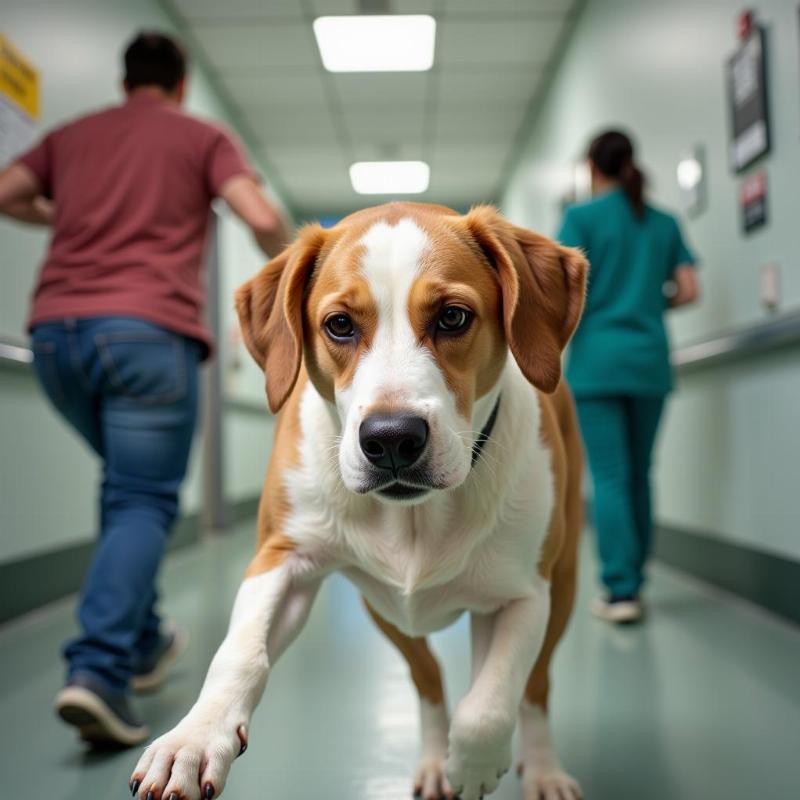The phrase “how to get my dog high” is alarming. While some might be curious about this, it’s crucial to understand that intentionally intoxicating a dog is dangerous, unethical, and potentially fatal. This article will address the dangers of exposing dogs to substances that alter their mental state and offer safe, enriching alternatives to ensure your furry friend’s well-being. We’ll discuss why dogs should never be given drugs and explore healthy ways to stimulate their minds and bodies.
Exposing your dog to any substance intended to get them “high” is reckless and harmful. Dogs’ bodies process substances differently than humans, and what might be a mild intoxicant for a person can be toxic or even lethal for a dog. Even seemingly harmless substances like marijuana can cause severe neurological issues, respiratory problems, and even death in dogs. Never allow your dog access to recreational drugs, alcohol, or any other substance not specifically prescribed by a veterinarian. Their health and safety depend on your responsible care. What might seem like a harmless experiment can have devastating consequences. Instead of seeking ways to alter your dog’s mental state, focus on providing a stimulating and enriching environment that supports their natural behaviors and keeps them happy and healthy.
The Dangers of Intoxicating Your Dog
Understanding the potential harm of exposing your dog to intoxicating substances is paramount. Their smaller size and different metabolic processes make them highly susceptible to toxicity. Common signs of intoxication in dogs can range from vomiting and diarrhea to seizures, respiratory distress, and coma. Even if your dog appears to recover from an initial exposure, long-term damage to their organs, including the liver and kidneys, can occur.
 Dangers of Dog Intoxication
Dangers of Dog Intoxication
Common Household Dangers
Many common household items can be toxic to dogs. These include cleaning products, medications (both human and pet medications not prescribed for them), certain foods like chocolate and grapes, and even some common houseplants. Keep these items safely stored out of your dog’s reach. If you suspect your dog has ingested something toxic, contact your veterinarian or the ASPCA Animal Poison Control Center immediately.
Healthy Ways to Stimulate Your Dog
Instead of seeking to alter your dog’s mental state with harmful substances, focus on providing enrichment that fulfills their natural instincts and keeps them mentally and physically stimulated.
Physical Exercise and Play
Regular exercise is crucial for a dog’s physical and mental well-being. Daily walks, runs, playtime in the park, or engaging in dog sports like agility or flyball can provide the physical stimulation they need.
Mental Enrichment
Mental stimulation is just as important as physical exercise. Puzzle toys, training sessions, and even simple games like hide-and-seek can keep your dog’s mind sharp and prevent boredom. Rotating their toys regularly can also keep them engaged and prevent them from getting tired of the same old things.
Social Interaction
Dogs are social creatures and thrive on interaction with both humans and other dogs. Regularly socializing your dog with other dogs at the park or through organized playgroups can provide valuable social enrichment. Spending quality time with your dog, cuddling, playing, and simply being present can strengthen your bond and contribute to their overall happiness.
Providing a Safe and Enriching Environment
Creating a safe and stimulating environment for your dog is essential for their overall well-being. This involves not only protecting them from harmful substances but also providing opportunities for them to engage in natural behaviors.
dog crates for labrador retriever
Chew Toys and Enrichment Activities
Providing a variety of chew toys can help satisfy a dog’s natural chewing instincts and prevent destructive chewing. Enrichment activities like scent work or learning new tricks can also keep them mentally stimulated.
Consistent Routine and Positive Reinforcement
A consistent daily routine can provide a sense of security for your dog. Positive reinforcement training methods, using rewards and praise, are the most effective and humane way to train your dog and build a strong bond.
ferplast atlas vehicle suv dog crate
Conclusion
Instead of searching for “how to get my dog high,” prioritize creating a happy, healthy, and enriching life for your canine companion. Focus on providing them with plenty of exercise, mental stimulation, and social interaction. Remember, your dog’s well-being is your responsibility. By making responsible choices and providing a stimulating environment, you can ensure your dog lives a long, fulfilling, and sober life.
FAQ
- What should I do if I suspect my dog has ingested something toxic? Immediately contact your veterinarian or the ASPCA Animal Poison Control Center.
- What are some signs of intoxication in dogs? Vomiting, diarrhea, seizures, respiratory distress, disorientation, and coma.
- What are some safe ways to provide mental stimulation for my dog? Puzzle toys, training sessions, hide-and-seek, and rotating their toys.
- How much exercise does my dog need? This depends on the breed and age, but most dogs benefit from daily walks and playtime.
- What are the benefits of positive reinforcement training? It’s the most effective and humane way to train, building a strong bond with your dog.
- How can I create a safe environment for my dog? Keep toxic substances out of reach, provide appropriate chew toys, and establish a consistent routine.
- Why is social interaction important for dogs? Dogs are social creatures and thrive on interaction with both humans and other dogs.
Beautdogs.us is your premier resource for comprehensive dog care information, breed-specific advice, and top-quality products tailored to the American dog owner. Whether you’re a seasoned dog lover or a new pet parent, Beautdogs.us offers expert guidance and a wealth of resources to help you navigate every aspect of dog ownership. Contact us for all your dog-related needs at [email protected] or +1 501-555-7529.